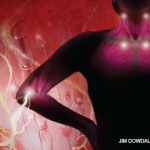
Dr. Singla
Saimun Singla, DO, a pediatric rheumatologist and owner of Rheum to Grow in Houston, can empathize when her young patients discuss the challenges of managing stiff and painful joints.
Board-certified in general pediatrics and pediatric rheumatology, and fellowship-trained in integrative medicine, Dr. Singla’s knowledge of rheumatic diseases goes far beyond what she learned in her formal education. While working as an attending physician at Texas Children’s Hospital, Houston, Dr. Singla was diagnosed with rheumatoid arthritis (RA).
The Journey Begins
“Shortly after giving birth to my second child, who is now 7, I started experiencing fatigue, stiffness and pain in my fingers,” Dr. Singla says. “While I knew women have a higher rate of developing autoimmune disease after a pregnancy, I initially chalked my symptoms up to having a toddler, a new baby and a busy medical practice.”
Over time, Dr. Singla noticed her symptoms were becoming worse, and she reached out to a colleague who specialized in adult rheumatol- ogy asking for a consult.
“I told her it was probably nothing, but she insisted I come in during her lunch break,” Dr. Singla says. “After conducting an exam, she diagnosed me with inflammatory RA, which wasn’t the diagnosis I had anticipated. I was shocked.”
Dr. Singla was initially prescribed hydroxychloroquine (Plaquenil) and a short course of corticosteroids, but she continued to experience stiff- ness. After a few months, her rheumatologist added adalimumab (Humira) to her treatment regimen.
Then Dr. Singla experienced an allergic reaction to adalimumab. “I woke up one morning with swollen lips and eyes the day after my injec- tion,” she says. “I tried several different biologic medications after that, and I’m currently taking a combination of Cimzia [certolizumab pegol] and methotrexate injections.”
Introducing Integrative Care
After years of trying and exhausting different medication options, Dr. Singla realized she was both living and practicing medicine in a sick care model of healthcare focused exclusively on disease management.
“As physicians, we’re trained to focus on the biology and treatment of disease,” Dr. Singla says. “This is, and should be, the heart of our medical training, but blind focus on this aspect of medicine misses other variables that contribute to disease. Until I was diagnosed with RA, I never realized how much such factors as sleep, diet and stress contribute to arthritis flares.”
At the time, Dr. Singla was also fielding questions from families about how they could help their children live better lives that went beyond non-steroidal anti- inflammatory drugs (NSAIDs), corticosteroids, biologics and disease-modifying anti-rheumatic medications (DMARDs).
“I have parents who want to reduce the amount of medication their child is taking or who ask how they can minimize the side effects,” Dr. Singla says. “They ask whether an anti-inflammatory diet could help with their child’s inflammation and pain, or whether adding nutritional supplements may help their child’s condition.”
While she didn’t have all the answers, Dr. Singla was curious to learn other ways she could help her young patients live well with a rheumatic condition. She decided to enroll in the Integrative Medicine Fellowship offered through the Andrew Weil Center for Integrative Medicine, University of Arizona, Tucson. The 1,000-hour, two-year online learning program with a clinical mentorship program trains more than 160 fellows annually.
“I’ve learned that many families attempt integrative treatments on their own, without knowing the risks vs. benefits,” Dr. Singla says. “The fellowship offered me a broader perspective on caring for patients, and the ability to advise them on evidence-based integrative medicine options that can complement their traditional rheumatology care.”
When meeting with her patients today, Dr. Singla takes a holistic approach to their care, looking at how sleep, nutrition, exercise and other mind-body approaches, such as breathwork, journaling or meditation, may benefit her patients, in addition to medication.
“Sleep is a critical factor for managing my own RA,” Dr. Singla says. “If I don’t get eight or nine hours of sleep, my joints feel achy and stiff.”
She also encourages her RA patients to track pain, fatigue and other symptoms and to identify any flare triggers, such as movement, specific foods, weather and stress.
“I’ve found my own flare triggers are drinking red wine and eating certain meats,” Dr. Singla says. “I started eating a primarily plant- based diet and can feel the difference.”
By combining integrative medi- cine with her medical school and fellowship training, Dr. Singla says she’s able to offer her patients a wider array of therapies and enable them to become active partners in their healthcare through shared decision making.
Street Cred
“Having RA has made me more empathetic to the challenges my patients face on a daily basis,” Dr. Singla says. “Having a chronic illness is like riding a mental/emotional rollercoaster and pediatric patients have to learn how to manage a life-long illness.”
She also says her condition has given her street cred with her patients, who know she can relate to their challenges personally and offer solutions that have helped her own condition. It also provides some relief when families hear that she takes similar medications with similar side effects.
Reducing Symptoms
“Since I get a lot of stiffness in my hands, I’ve found that wearing compression gloves at night helps reduce pain and morning stiffness,” she says. “Using paraffin wax on my hands also helps loosen up my hand and finger joints, and reduce pain.”
Dr. Singla also encourages her patients to remain as active as they can and to participate in low-impact activities that interest them, such as swimming, walking or biking.
“I’ve found personally that yoga and resistance training with weights help with my stiffness,” she says.
Because stress and RA are linked, with stress often setting off the immune system’s inflammatory response, Dr. Singla also recommends a wide array of mind-body therapies, such as talk therapy, support groups, art therapy, breathwork and meditation.
“In my own life, I now wake up each morning and do a six-minute meditation to start off my day,” Dr. Singla says. “It helps ease the stress that comes with balancing a busy career and motherhood. I think it works for me because this routine gives me some sense of control before the day even begins. It’s kind of like my emotional armor for the rest of the day.”
Linda Childers is a health writer located in the San Francisco Bay Area.



